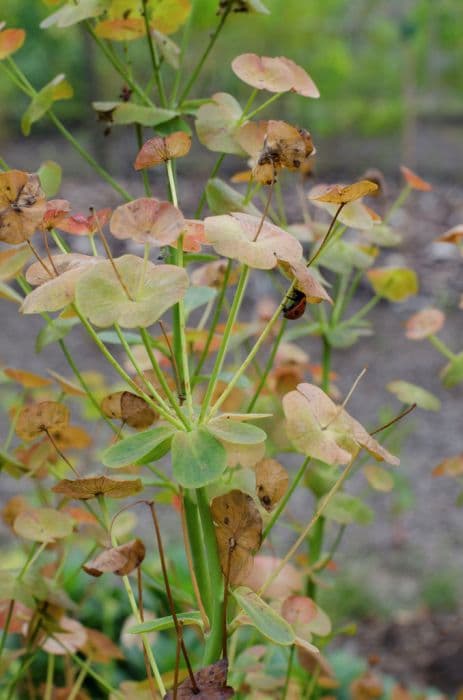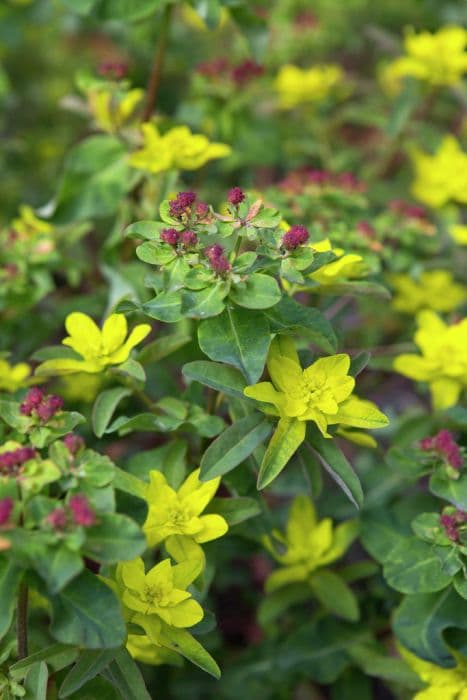Variegated Devil's Backbone Pedilanthus tithymaloides 'Variegatus' (v)

ABOUT
The plant commonly known as Variegated Devil's Backbone is a visually striking plant with a unique and distinctive appearance. As a variegated cultivar, its foliage stands out with a mix of green and creamy white or yellow patterns. The leaves themselves are fleshy and have a zigzagging arrangement, giving rise to the Devil's Backbone common name. The overall impression is of a sculptural plant with a playful yet elegant form that catches the eye thanks to its color contrasts and the peculiar arrangement of its foliage. The patterns on the leaves can range from broad, creamy bands to more intricate marbling, adding to the plant's ornamental value. The stems of this variety may also have hints of pink, adding to the plant's colorful display. The plant may occasionally produce small, inconspicuous flowers, but it is primarily grown for its attractive leaf variegation.
About this plant
 Names
NamesSynonyms
Variegated Devil's Backbone, Jacob's Ladder, Japanese Poinsettia, Red Bird Flower, Christmas Candle.
Common names
Euphorbia tithymaloides var. variegata, Euphorbia tithymaloides 'Variegatus'.
 Toxicity
ToxicityTo humans
The plant Pedilanthus tithymaloides 'Variegatus', commonly known as the variegated devil's backbone, contains toxic substances and can be harmful if ingested. The toxicity mainly stems from the milky sap that the plant secretes, which contains diterpenes. If someone consumes any part of the variegated devil's backbone, they may experience symptoms such as vomiting, diarrhea, and a burning sensation in the throat or mouth. In severe cases, ingestion can lead to more serious symptoms, including difficulty breathing and a drop in blood pressure. It is important to handle this plant with care and to not ingest any part of it.
To pets
The variegated devil's backbone is toxic to pets. If a pet ingests any part of this plant, it could experience symptoms similar to those in humans, including vomiting, diarrhea, and pain or irritation in the mouth or throat. The plant's sap can be particularly irritating and can lead to symptoms such as swelling or redness in the affected area. In some cases, more severe reactions such as difficulty breathing or changes in heart rate may occur. It is crucial to keep this plant out of reach of pets to prevent accidental ingestion.
 Characteristics
CharacteristicsLife cycle
Perennials
Foliage type
Evergreen
Color of leaves
Variegated
Flower color
Red
Height
2-4 feet (0.6-1.2 meters)
Spread
1-2 feet (0.3-0.6 meters)
Plant type
Shrub
Hardiness zones
10
Native area
Caribbean Central America South America
Benefits
 General Benefits
General Benefits- Easy Maintenance: Variegated Devil's Backbone is known for being low maintenance and easy to care for, making it suitable for novice gardeners.
- Drought Tolerance: The plant is drought tolerant, which means it requires minimal watering and can survive in dry conditions once established.
- Pest Resistance: It has a natural resistance to many pests, reducing the need for chemical treatments.
- Architectural Interest: Its unique zigzag stems and variegated foliage add visual interest and structure to garden designs.
- Adaptability: Variegated Devil's Backbone can grow in a range of soil types, as long as there is good drainage.
- Container Planting: It is well-suited for container planting, allowing it to be used as a decorative element on patios, balconies, and indoors.
 Medical Properties
Medical Properties- Pain relief: Some cultures have used the sap for its analgesic properties.
- Anti-inflammatory: The plant has been traditionally used to reduce swelling and inflammation.
- Antiseptic: The sap has been applied to cuts and wounds to prevent infection.
- Skin conditions: Poultices of the plant have been used to treat skin ailments such as eczema and psoriasis.
- Laxative effects: It has been reportedly used in traditional medicine as a mild laxative.
- Antipyretic: There are claims of its use to reduce fever in certain traditional medicinal practices.
 Air-purifying Qualities
Air-purifying QualitiesThis plant is not specifically known for air purifying qualities.
 Other Uses
Other Uses- Pedilanthus tithymaloides 'Variegatus' or commonly known as Variegated Devil's Backbone, due to its unique appearance, is often used as a living sculpture or topiary in ornamental gardens.
- They can be trained to grow in intricate shapes and forms, making them perfect for whimsical garden designs or as conversation pieces in patio settings.
- The striking coloration of the Variegated Devil's Backbone makes it a vibrant addition to floral arrangements and can add an exotic touch to bouquets.
- Its drought tolerance makes it suitable for xeriscaping, a landscaping method that reduces or eliminates the need for supplemental water from irrigation.
- The plant can be used in educational settings to demonstrate plant propagation techniques as it easily roots from cuttings.
- In creativity projects, the plant’s sap can be used as a natural latex paint or as a protective coat over certain artworks.
- Variegated Devil's Backbone can also be used in container gardening to add height and texture among other low-growing plants.
- Due to its structured and upright growth habit, it serves as an excellent backdrop for photographing smaller plants and garden features.
- Its resilient nature allows it to be employed in urban landscaping, coping well with pollution and providing greenery in cities.
- In coastal areas, the Variegated Devil's Backbone can be utilized to contribute to the stabilization of sand dunes due to its root system.
Interesting Facts
 Feng Shui
Feng ShuiDevil's Backbone is not used in Feng Shui practice.
 Zodiac Sign Compitability
Zodiac Sign CompitabilityDevil's Backbone is not used in astrology practice.
 Plant Symbolism
Plant Symbolism- Protection: Due to its somewhat toxic nature, the Devil's Backbone is often regarded as a plant that wards off negative energy and protects the home from evil spirits.
- Adaptability: As a plant that can thrive in various conditions, Devil's Backbone symbolizes the ability to adapt and survive in different environments.
- Unique Beauty: With its striking variegated leaves, the Devil's Backbone represents the beauty in uniqueness and standing out from the crowd.
- Healing: Although the plant is toxic, in some cultures, it is believed to have medicinal properties, symbolizing healing and the duality of nature—both harmful and beneficial.
- Resilience: The Devil's Backbone is a hardy plant that can withstand neglect, symbolizing resilience and the capacity to overcome challenging circumstances.
 Water
WaterDevil's Backbone should be watered thoroughly, allowing the top layer of soil to dry out between waterings, which typically means watering approximately once a week, dependant on environmental conditions. During spring and summer, the active growth period, keep the soil consistently moist but not soggy. During the fall and winter months, reduce watering to every other week or less, providing only enough to prevent the soil from completely drying out. A general guideline is to provide about 8 to 16 ounces of water for smaller pots or up to 1 gallon for larger pots during each watering session, adjusting as needed for the plant’s size and the humidity.
 Light
LightDevil's Backbone thrives in bright, indirect light or partial shade. It is best to place the plant in a location where it receives filtered sunlight throughout the day, such as near an east or west-facing window. Direct sunlight, especially during the hotter parts of the day, can lead to leaf scorch, so it’s essential to avoid placing it in full sun exposure.
 Temperature
TemperatureDevil's Backbone prefers temperatures between 60 and 85 degrees Fahrenheit but can tolerate a range from 50 to 100 degrees Fahrenheit. To maintain optimal growth, keep it away from drafts and sudden temperature changes which can stress the plant. The ideal conditions for Devil's Backbone are a stable environment without extreme fluctuations in temperature.
 Pruning
PruningPrune Devil's Backbone to maintain its shape and encourage bushier growth. It is best pruned in early spring before new growth starts. You can prune every couple of months or as needed when the plant becomes leggy or overgrown. The best time for pruning is alongside the early stages of the growing season to allow the plant to heal and regrow quickly.
 Cleaning
CleaningAs needed
 Soil
SoilDevil's Backbone prefers a well-draining soil mix, like cactus potting mix with added perlite to enhance drainage. An ideal soil pH level for Pedilanthus tithymaloides 'Variegatus' should be around 6.5 to 7.5, slightly acidic to neutral.
 Repotting
RepottingDevil's Backbone should be repotted every 2-3 years or when it outgrows its current pot, usually evident by roots crowding the container.
 Humidity & Misting
Humidity & MistingDevil's Backbone thrives in average room humidity levels, around 40-50%, and can tolerate lower humidity but might need extra care.
 Suitable locations
Suitable locationsIndoor
Place Devil's Backbone in bright, indirect light indoors.
Outdoor
Situate Devil's Backbone in partial shade outdoors.
Hardiness zone
9-11 USDA
 Life cycle
Life cyclePedilanthus tithymaloides 'Variegatus', commonly known as variegated devil's backbone, begins its life cycle as a seed that germinates in warm, moist soil conditions. As a seedling, it develops fleshy, zig-zag patterned stems with variegated leaves that show creamy white and green patterns. The juvenile plant grows rapidly under bright, indirect light and with sufficient moisture, maturing into a bushy, upright plant. During its mature stage, the variegated devil's backbone may produce small, inconspicuous flowers, usually in summer, followed by the development of seed capsules. After several years, as it reaches the end of its life span, growth slows down, and it may become leggy or lose vigor. At any stage, it can be propagated through stem cuttings, encouraging the cycle to begin anew with the growth of daughter plants.
 Propogation
PropogationPropogation time
Spring-Early Summer
Pedilanthus tithymaloides 'Variegatus', commonly known as variegated devil's backbone, is often propagated through stem cuttings. The ideal time for taking cuttings is during the warmer months, from late spring to early summer, when the plant is actively growing. To propagate, select a healthy, non-flowering stem and cut a 4 to 6 inch (approximately 10 to 15 centimeters) segment. Remove the lower leaves and allow the cutting to callus over for a day or two to reduce the risk of rot. Then, insert the cutting into a well-draining soil mix and keep it moist but not waterlogged. Provide bright, indirect light and maintain a consistent temperature to encourage rooting, which should occur within a few weeks. After the cuttings have rooted and established, they can be transplanted to their final locations.


![Spurge [Silver Swan]](/_next/image?url=https%3A%2F%2Fplants-admin.emdemapps.com%2Fimages%2Fplants%2F%2Fimages%2F604b573f6c8f6.png&w=640&q=75)






